International Monetary Fund (IMF) and Financial Stability
VerifiedAdded on 2020/01/07
|60
|22846
|188
Report
AI Summary
This report provides a comprehensive analysis of the International Monetary Fund (IMF) and its crucial role in navigating and mitigating global financial crises. The report begins with an overview of the IMF's inception in 1945, its objectives, and its evolution from the Bretton Woods agreement. It delves into the IMF's functions, including providing financial assistance, monitoring exchange rates, and offering technical support to member nations. The study examines the IMF's strategies for promoting financial stability, its responses to major economic downturns, and its impact on developing countries. The report also explores the IMF's financial structure, its relationship with international financial laws, and the effectiveness of its policies. Through an examination of the IMF's operations and interventions, the research aims to illustrate how the organization addresses financial emergencies, supports economic growth, and contributes to a more stable global financial system. The report also includes a review of the literature, research methodology, data analysis, and recommendations for future strategies.
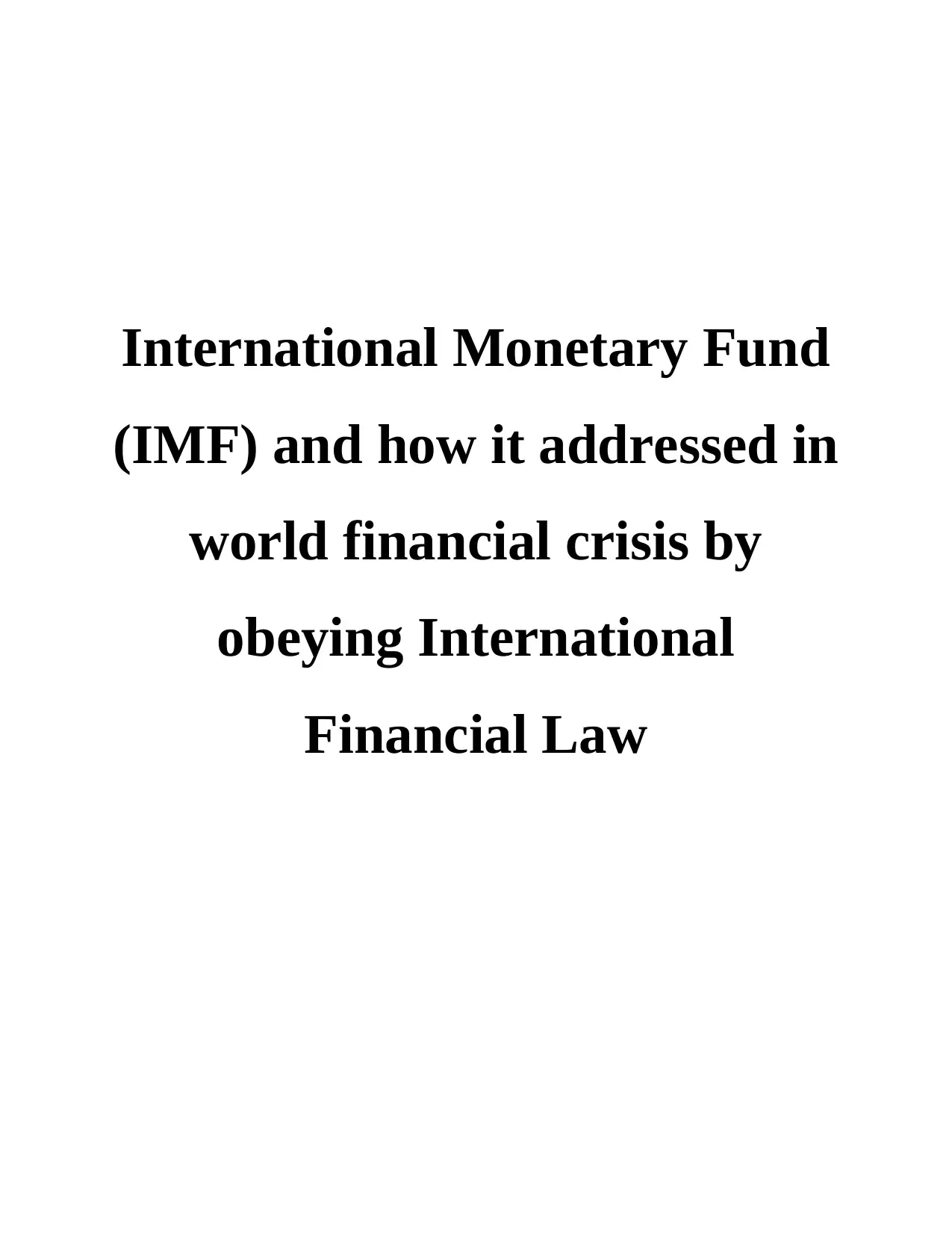
International Monetary Fund
(IMF) and how it addressed in
world financial crisis by
obeying International
Financial Law
(IMF) and how it addressed in
world financial crisis by
obeying International
Financial Law
Paraphrase This Document
Need a fresh take? Get an instant paraphrase of this document with our AI Paraphraser
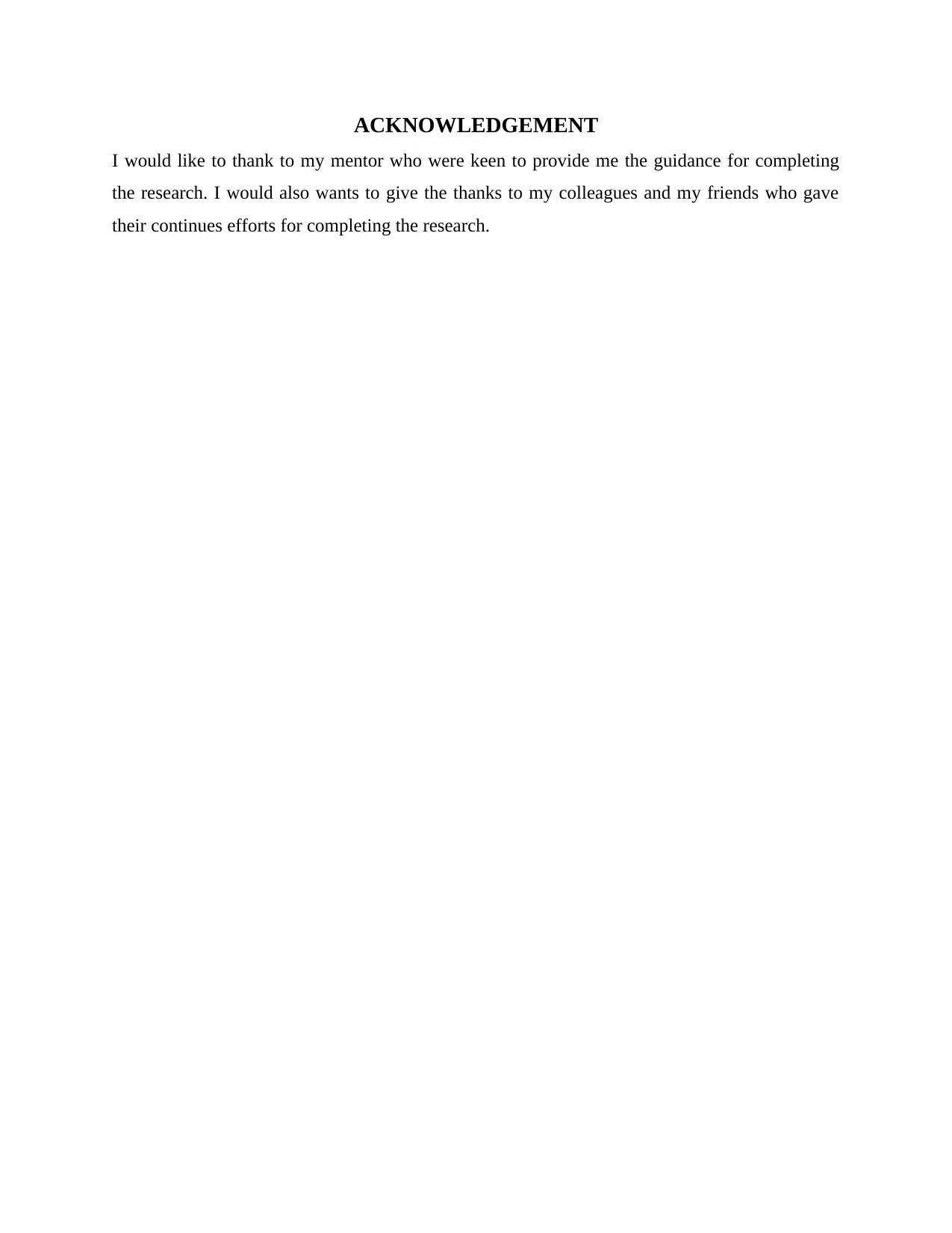
ACKNOWLEDGEMENT
I would like to thank to my mentor who were keen to provide me the guidance for completing
the research. I would also wants to give the thanks to my colleagues and my friends who gave
their continues efforts for completing the research.
I would like to thank to my mentor who were keen to provide me the guidance for completing
the research. I would also wants to give the thanks to my colleagues and my friends who gave
their continues efforts for completing the research.
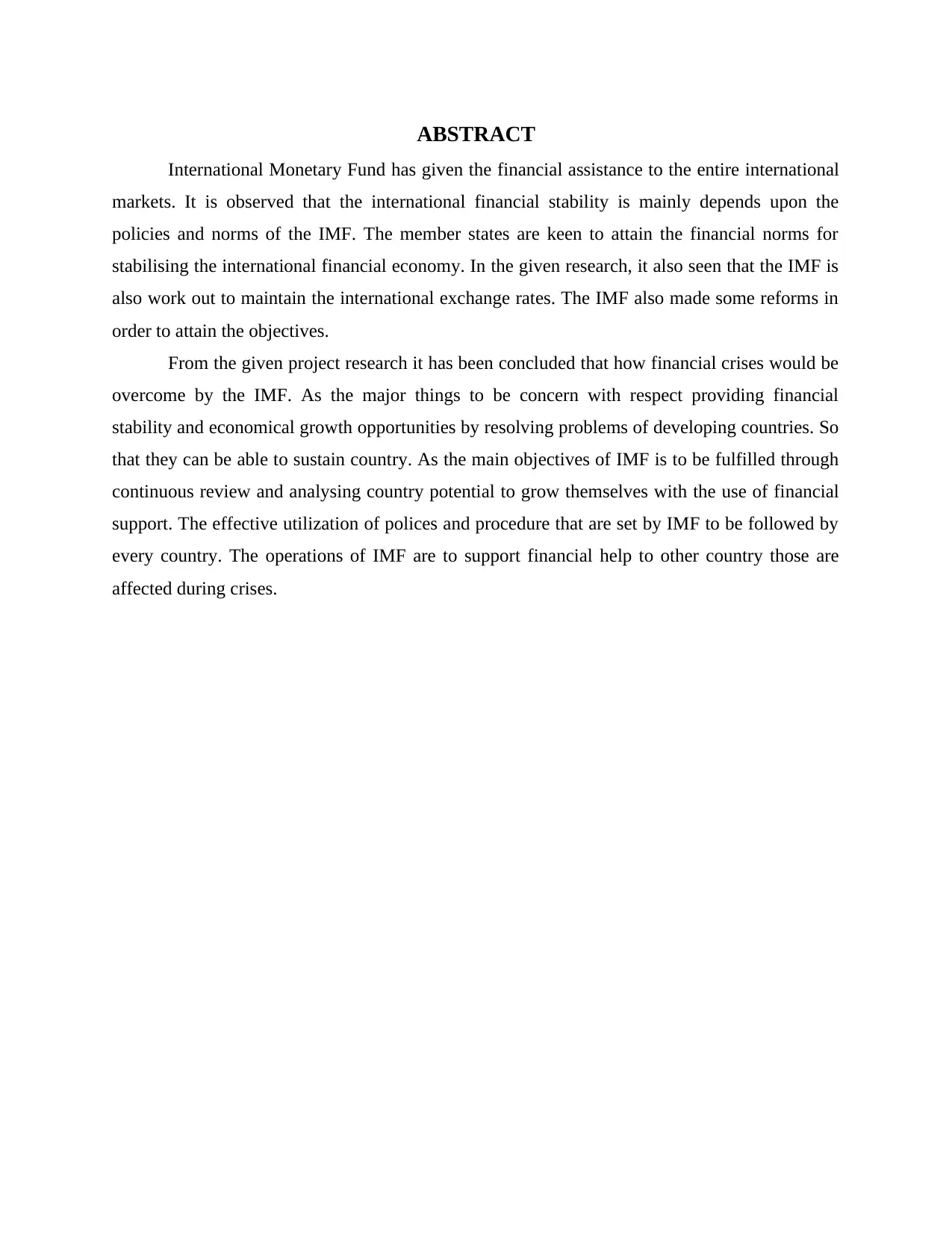
ABSTRACT
International Monetary Fund has given the financial assistance to the entire international
markets. It is observed that the international financial stability is mainly depends upon the
policies and norms of the IMF. The member states are keen to attain the financial norms for
stabilising the international financial economy. In the given research, it also seen that the IMF is
also work out to maintain the international exchange rates. The IMF also made some reforms in
order to attain the objectives.
From the given project research it has been concluded that how financial crises would be
overcome by the IMF. As the major things to be concern with respect providing financial
stability and economical growth opportunities by resolving problems of developing countries. So
that they can be able to sustain country. As the main objectives of IMF is to be fulfilled through
continuous review and analysing country potential to grow themselves with the use of financial
support. The effective utilization of polices and procedure that are set by IMF to be followed by
every country. The operations of IMF are to support financial help to other country those are
affected during crises.
International Monetary Fund has given the financial assistance to the entire international
markets. It is observed that the international financial stability is mainly depends upon the
policies and norms of the IMF. The member states are keen to attain the financial norms for
stabilising the international financial economy. In the given research, it also seen that the IMF is
also work out to maintain the international exchange rates. The IMF also made some reforms in
order to attain the objectives.
From the given project research it has been concluded that how financial crises would be
overcome by the IMF. As the major things to be concern with respect providing financial
stability and economical growth opportunities by resolving problems of developing countries. So
that they can be able to sustain country. As the main objectives of IMF is to be fulfilled through
continuous review and analysing country potential to grow themselves with the use of financial
support. The effective utilization of polices and procedure that are set by IMF to be followed by
every country. The operations of IMF are to support financial help to other country those are
affected during crises.
⊘ This is a preview!⊘
Do you want full access?
Subscribe today to unlock all pages.

Trusted by 1+ million students worldwide
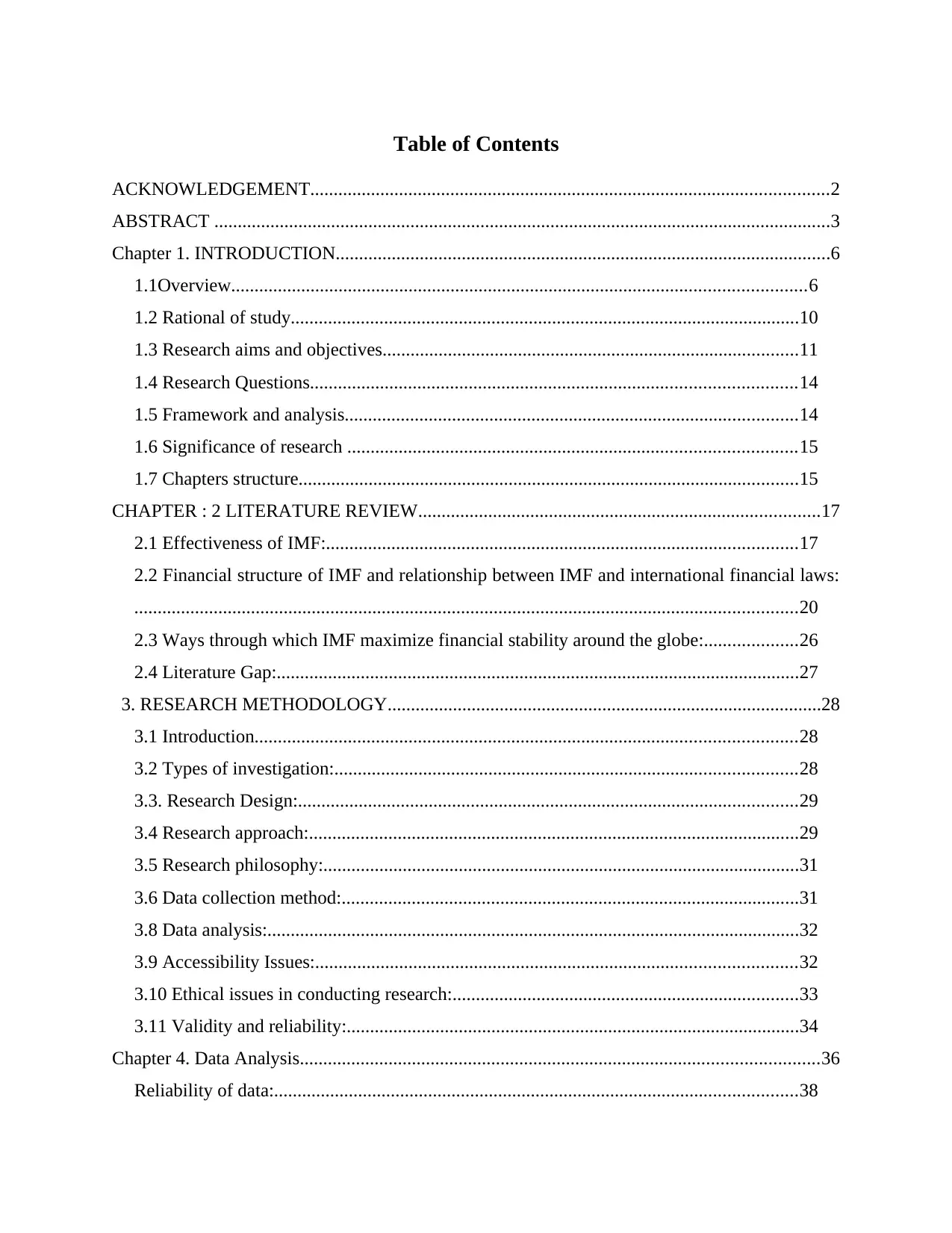
Table of Contents
ACKNOWLEDGEMENT...............................................................................................................2
ABSTRACT ....................................................................................................................................3
Chapter 1. INTRODUCTION..........................................................................................................6
1.1Overview...........................................................................................................................6
1.2 Rational of study.............................................................................................................10
1.3 Research aims and objectives.........................................................................................11
1.4 Research Questions........................................................................................................14
1.5 Framework and analysis.................................................................................................14
1.6 Significance of research ................................................................................................15
1.7 Chapters structure...........................................................................................................15
CHAPTER : 2 LITERATURE REVIEW......................................................................................17
2.1 Effectiveness of IMF:.....................................................................................................17
2.2 Financial structure of IMF and relationship between IMF and international financial laws:
..............................................................................................................................................20
2.3 Ways through which IMF maximize financial stability around the globe:....................26
2.4 Literature Gap:................................................................................................................27
3. RESEARCH METHODOLOGY.............................................................................................28
3.1 Introduction....................................................................................................................28
3.2 Types of investigation:...................................................................................................28
3.3. Research Design:...........................................................................................................29
3.4 Research approach:.........................................................................................................29
3.5 Research philosophy:......................................................................................................31
3.6 Data collection method:..................................................................................................31
3.8 Data analysis:..................................................................................................................32
3.9 Accessibility Issues:.......................................................................................................32
3.10 Ethical issues in conducting research:..........................................................................33
3.11 Validity and reliability:.................................................................................................34
Chapter 4. Data Analysis...............................................................................................................36
Reliability of data:................................................................................................................38
ACKNOWLEDGEMENT...............................................................................................................2
ABSTRACT ....................................................................................................................................3
Chapter 1. INTRODUCTION..........................................................................................................6
1.1Overview...........................................................................................................................6
1.2 Rational of study.............................................................................................................10
1.3 Research aims and objectives.........................................................................................11
1.4 Research Questions........................................................................................................14
1.5 Framework and analysis.................................................................................................14
1.6 Significance of research ................................................................................................15
1.7 Chapters structure...........................................................................................................15
CHAPTER : 2 LITERATURE REVIEW......................................................................................17
2.1 Effectiveness of IMF:.....................................................................................................17
2.2 Financial structure of IMF and relationship between IMF and international financial laws:
..............................................................................................................................................20
2.3 Ways through which IMF maximize financial stability around the globe:....................26
2.4 Literature Gap:................................................................................................................27
3. RESEARCH METHODOLOGY.............................................................................................28
3.1 Introduction....................................................................................................................28
3.2 Types of investigation:...................................................................................................28
3.3. Research Design:...........................................................................................................29
3.4 Research approach:.........................................................................................................29
3.5 Research philosophy:......................................................................................................31
3.6 Data collection method:..................................................................................................31
3.8 Data analysis:..................................................................................................................32
3.9 Accessibility Issues:.......................................................................................................32
3.10 Ethical issues in conducting research:..........................................................................33
3.11 Validity and reliability:.................................................................................................34
Chapter 4. Data Analysis...............................................................................................................36
Reliability of data:................................................................................................................38
Paraphrase This Document
Need a fresh take? Get an instant paraphrase of this document with our AI Paraphraser
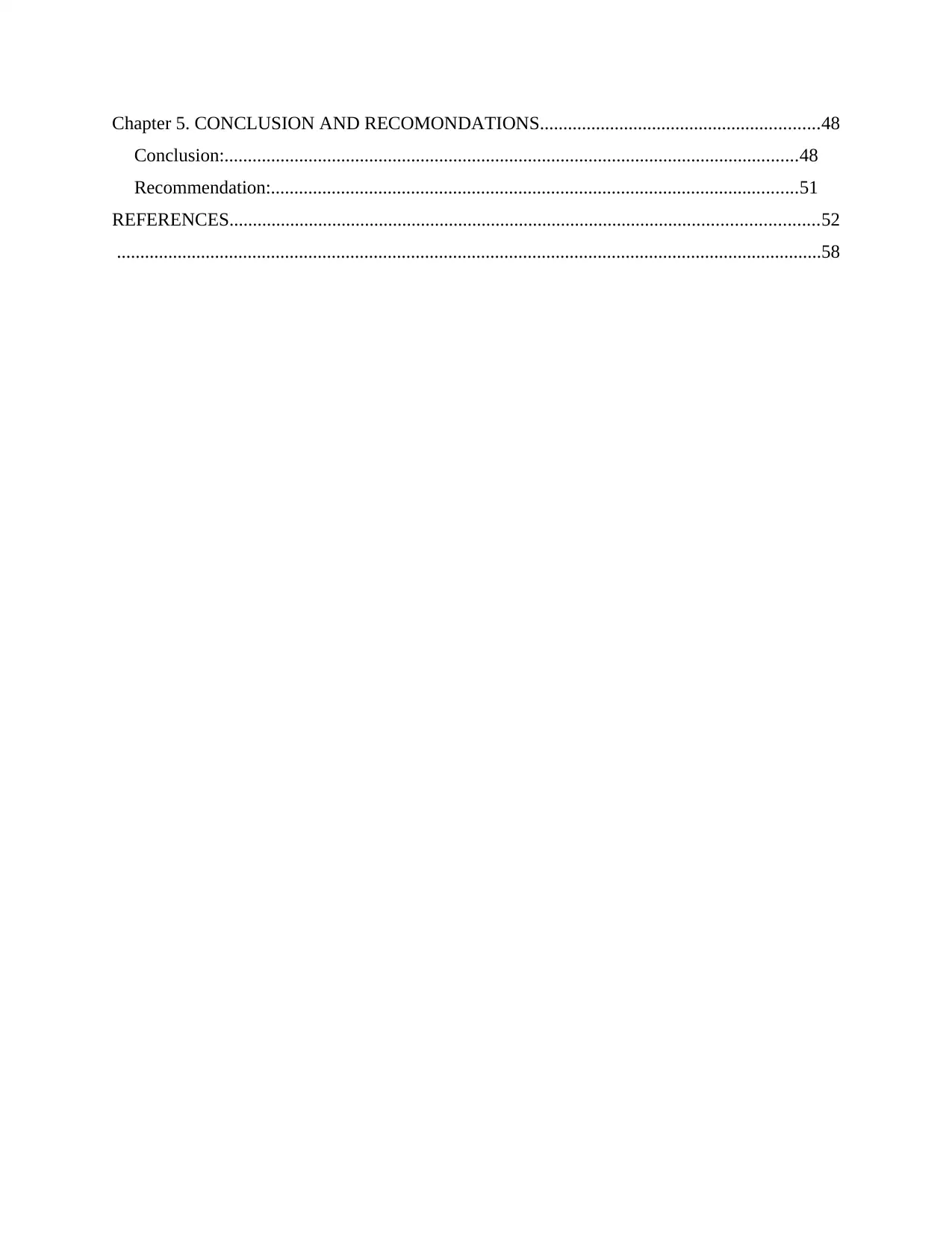
Chapter 5. CONCLUSION AND RECOMONDATIONS............................................................48
Conclusion:...........................................................................................................................48
Recommendation:.................................................................................................................51
REFERENCES..............................................................................................................................52
.......................................................................................................................................................58
Conclusion:...........................................................................................................................48
Recommendation:.................................................................................................................51
REFERENCES..............................................................................................................................52
.......................................................................................................................................................58
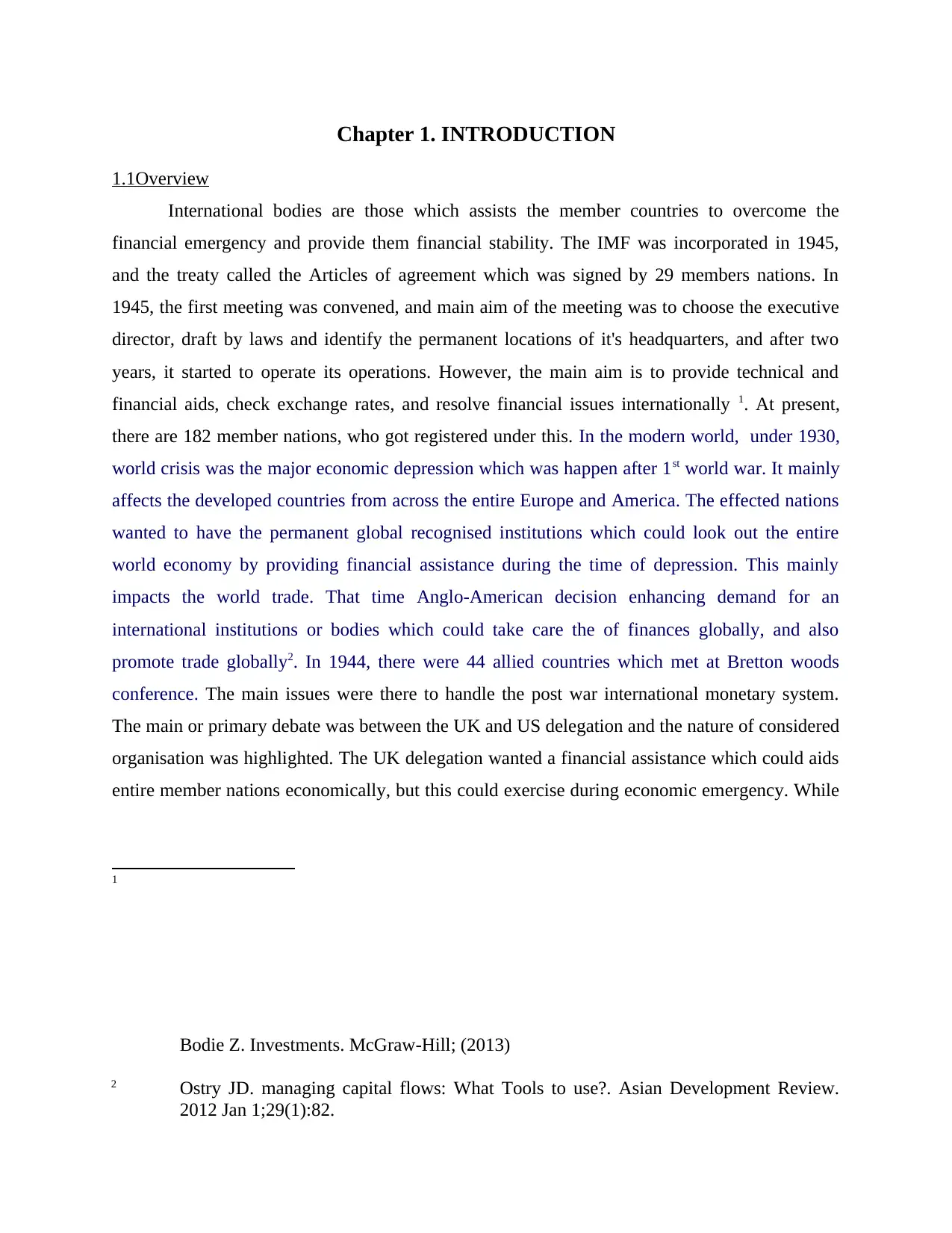
Chapter 1. INTRODUCTION
1.1Overview
International bodies are those which assists the member countries to overcome the
financial emergency and provide them financial stability. The IMF was incorporated in 1945,
and the treaty called the Articles of agreement which was signed by 29 members nations. In
1945, the first meeting was convened, and main aim of the meeting was to choose the executive
director, draft by laws and identify the permanent locations of it's headquarters, and after two
years, it started to operate its operations. However, the main aim is to provide technical and
financial aids, check exchange rates, and resolve financial issues internationally 1. At present,
there are 182 member nations, who got registered under this. In the modern world, under 1930,
world crisis was the major economic depression which was happen after 1st world war. It mainly
affects the developed countries from across the entire Europe and America. The effected nations
wanted to have the permanent global recognised institutions which could look out the entire
world economy by providing financial assistance during the time of depression. This mainly
impacts the world trade. That time Anglo-American decision enhancing demand for an
international institutions or bodies which could take care the of finances globally, and also
promote trade globally2. In 1944, there were 44 allied countries which met at Bretton woods
conference. The main issues were there to handle the post war international monetary system.
The main or primary debate was between the UK and US delegation and the nature of considered
organisation was highlighted. The UK delegation wanted a financial assistance which could aids
entire member nations economically, but this could exercise during economic emergency. While
1
Bodie Z. Investments. McGraw-Hill; (2013)
2 Ostry JD. managing capital flows: What Tools to use?. Asian Development Review.
2012 Jan 1;29(1):82.
1.1Overview
International bodies are those which assists the member countries to overcome the
financial emergency and provide them financial stability. The IMF was incorporated in 1945,
and the treaty called the Articles of agreement which was signed by 29 members nations. In
1945, the first meeting was convened, and main aim of the meeting was to choose the executive
director, draft by laws and identify the permanent locations of it's headquarters, and after two
years, it started to operate its operations. However, the main aim is to provide technical and
financial aids, check exchange rates, and resolve financial issues internationally 1. At present,
there are 182 member nations, who got registered under this. In the modern world, under 1930,
world crisis was the major economic depression which was happen after 1st world war. It mainly
affects the developed countries from across the entire Europe and America. The effected nations
wanted to have the permanent global recognised institutions which could look out the entire
world economy by providing financial assistance during the time of depression. This mainly
impacts the world trade. That time Anglo-American decision enhancing demand for an
international institutions or bodies which could take care the of finances globally, and also
promote trade globally2. In 1944, there were 44 allied countries which met at Bretton woods
conference. The main issues were there to handle the post war international monetary system.
The main or primary debate was between the UK and US delegation and the nature of considered
organisation was highlighted. The UK delegation wanted a financial assistance which could aids
entire member nations economically, but this could exercise during economic emergency. While
1
Bodie Z. Investments. McGraw-Hill; (2013)
2 Ostry JD. managing capital flows: What Tools to use?. Asian Development Review.
2012 Jan 1;29(1):82.
⊘ This is a preview!⊘
Do you want full access?
Subscribe today to unlock all pages.

Trusted by 1+ million students worldwide
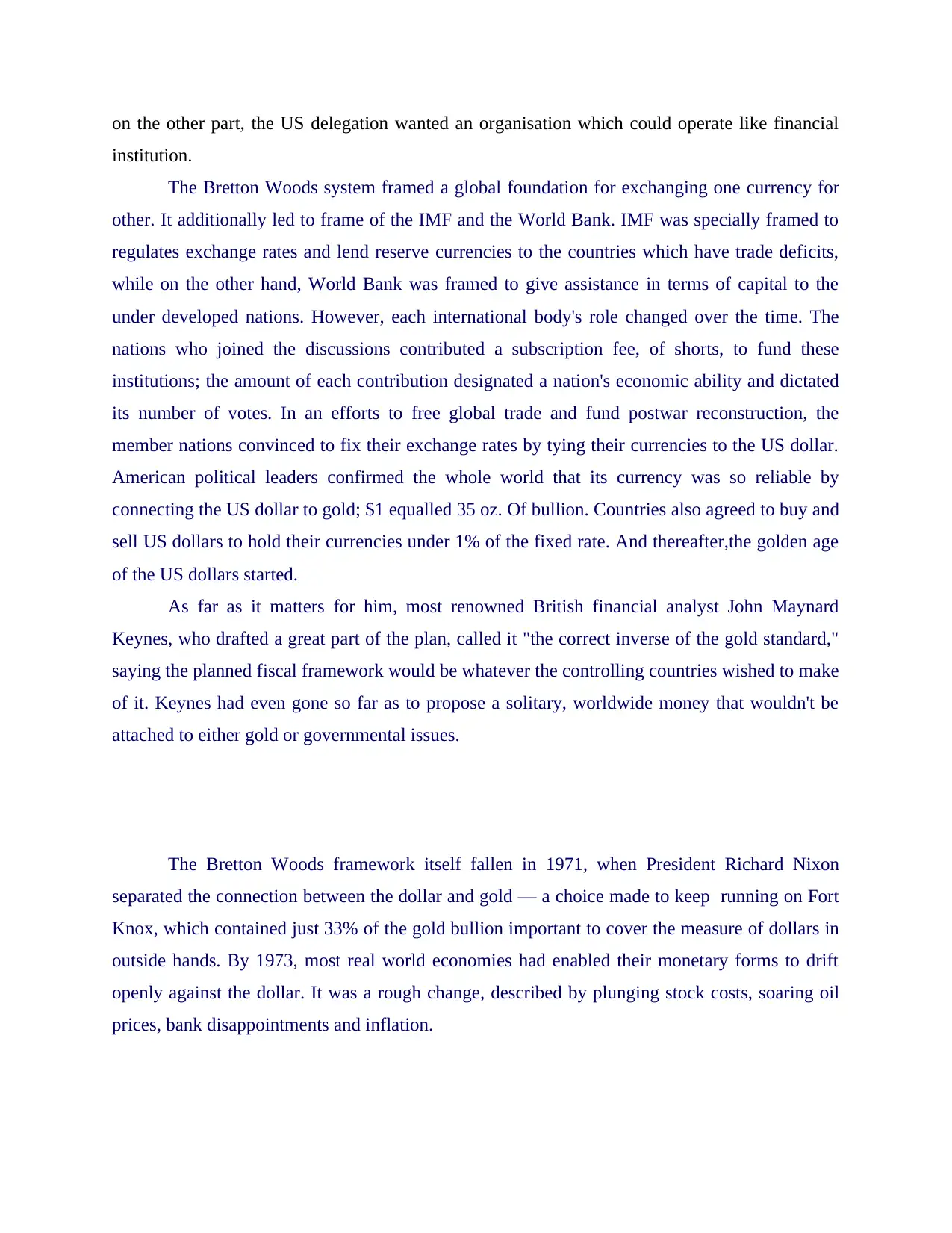
on the other part, the US delegation wanted an organisation which could operate like financial
institution.
The Bretton Woods system framed a global foundation for exchanging one currency for
other. It additionally led to frame of the IMF and the World Bank. IMF was specially framed to
regulates exchange rates and lend reserve currencies to the countries which have trade deficits,
while on the other hand, World Bank was framed to give assistance in terms of capital to the
under developed nations. However, each international body's role changed over the time. The
nations who joined the discussions contributed a subscription fee, of shorts, to fund these
institutions; the amount of each contribution designated a nation's economic ability and dictated
its number of votes. In an efforts to free global trade and fund postwar reconstruction, the
member nations convinced to fix their exchange rates by tying their currencies to the US dollar.
American political leaders confirmed the whole world that its currency was so reliable by
connecting the US dollar to gold; $1 equalled 35 oz. Of bullion. Countries also agreed to buy and
sell US dollars to hold their currencies under 1% of the fixed rate. And thereafter,the golden age
of the US dollars started.
As far as it matters for him, most renowned British financial analyst John Maynard
Keynes, who drafted a great part of the plan, called it "the correct inverse of the gold standard,"
saying the planned fiscal framework would be whatever the controlling countries wished to make
of it. Keynes had even gone so far as to propose a solitary, worldwide money that wouldn't be
attached to either gold or governmental issues.
The Bretton Woods framework itself fallen in 1971, when President Richard Nixon
separated the connection between the dollar and gold — a choice made to keep running on Fort
Knox, which contained just 33% of the gold bullion important to cover the measure of dollars in
outside hands. By 1973, most real world economies had enabled their monetary forms to drift
openly against the dollar. It was a rough change, described by plunging stock costs, soaring oil
prices, bank disappointments and inflation.
institution.
The Bretton Woods system framed a global foundation for exchanging one currency for
other. It additionally led to frame of the IMF and the World Bank. IMF was specially framed to
regulates exchange rates and lend reserve currencies to the countries which have trade deficits,
while on the other hand, World Bank was framed to give assistance in terms of capital to the
under developed nations. However, each international body's role changed over the time. The
nations who joined the discussions contributed a subscription fee, of shorts, to fund these
institutions; the amount of each contribution designated a nation's economic ability and dictated
its number of votes. In an efforts to free global trade and fund postwar reconstruction, the
member nations convinced to fix their exchange rates by tying their currencies to the US dollar.
American political leaders confirmed the whole world that its currency was so reliable by
connecting the US dollar to gold; $1 equalled 35 oz. Of bullion. Countries also agreed to buy and
sell US dollars to hold their currencies under 1% of the fixed rate. And thereafter,the golden age
of the US dollars started.
As far as it matters for him, most renowned British financial analyst John Maynard
Keynes, who drafted a great part of the plan, called it "the correct inverse of the gold standard,"
saying the planned fiscal framework would be whatever the controlling countries wished to make
of it. Keynes had even gone so far as to propose a solitary, worldwide money that wouldn't be
attached to either gold or governmental issues.
The Bretton Woods framework itself fallen in 1971, when President Richard Nixon
separated the connection between the dollar and gold — a choice made to keep running on Fort
Knox, which contained just 33% of the gold bullion important to cover the measure of dollars in
outside hands. By 1973, most real world economies had enabled their monetary forms to drift
openly against the dollar. It was a rough change, described by plunging stock costs, soaring oil
prices, bank disappointments and inflation.
Paraphrase This Document
Need a fresh take? Get an instant paraphrase of this document with our AI Paraphraser
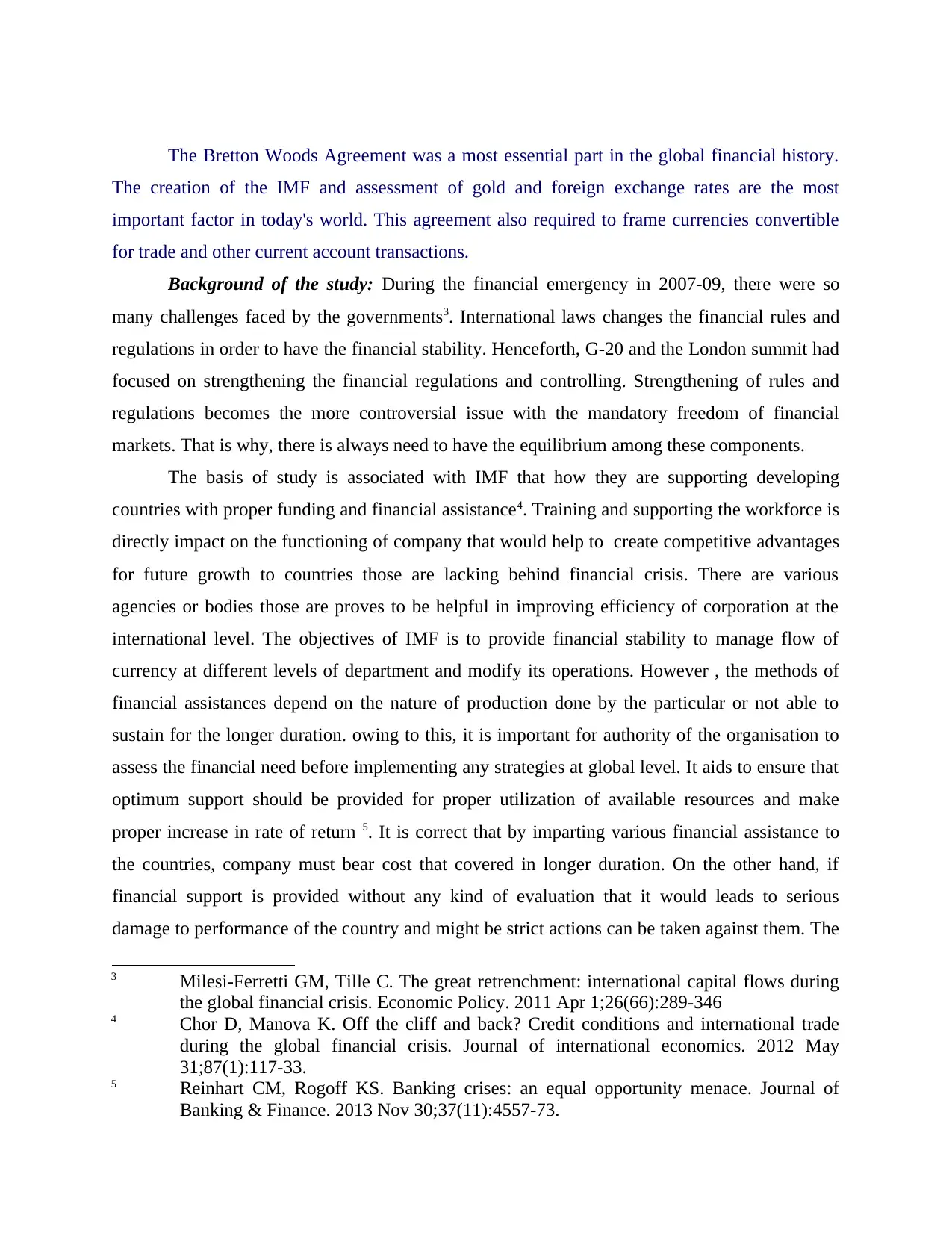
The Bretton Woods Agreement was a most essential part in the global financial history.
The creation of the IMF and assessment of gold and foreign exchange rates are the most
important factor in today's world. This agreement also required to frame currencies convertible
for trade and other current account transactions.
Background of the study: During the financial emergency in 2007-09, there were so
many challenges faced by the governments3. International laws changes the financial rules and
regulations in order to have the financial stability. Henceforth, G-20 and the London summit had
focused on strengthening the financial regulations and controlling. Strengthening of rules and
regulations becomes the more controversial issue with the mandatory freedom of financial
markets. That is why, there is always need to have the equilibrium among these components.
The basis of study is associated with IMF that how they are supporting developing
countries with proper funding and financial assistance4. Training and supporting the workforce is
directly impact on the functioning of company that would help to create competitive advantages
for future growth to countries those are lacking behind financial crisis. There are various
agencies or bodies those are proves to be helpful in improving efficiency of corporation at the
international level. The objectives of IMF is to provide financial stability to manage flow of
currency at different levels of department and modify its operations. However , the methods of
financial assistances depend on the nature of production done by the particular or not able to
sustain for the longer duration. owing to this, it is important for authority of the organisation to
assess the financial need before implementing any strategies at global level. It aids to ensure that
optimum support should be provided for proper utilization of available resources and make
proper increase in rate of return 5. It is correct that by imparting various financial assistance to
the countries, company must bear cost that covered in longer duration. On the other hand, if
financial support is provided without any kind of evaluation that it would leads to serious
damage to performance of the country and might be strict actions can be taken against them. The
3 Milesi-Ferretti GM, Tille C. The great retrenchment: international capital flows during
the global financial crisis. Economic Policy. 2011 Apr 1;26(66):289-346
4 Chor D, Manova K. Off the cliff and back? Credit conditions and international trade
during the global financial crisis. Journal of international economics. 2012 May
31;87(1):117-33.
5 Reinhart CM, Rogoff KS. Banking crises: an equal opportunity menace. Journal of
Banking & Finance. 2013 Nov 30;37(11):4557-73.
The creation of the IMF and assessment of gold and foreign exchange rates are the most
important factor in today's world. This agreement also required to frame currencies convertible
for trade and other current account transactions.
Background of the study: During the financial emergency in 2007-09, there were so
many challenges faced by the governments3. International laws changes the financial rules and
regulations in order to have the financial stability. Henceforth, G-20 and the London summit had
focused on strengthening the financial regulations and controlling. Strengthening of rules and
regulations becomes the more controversial issue with the mandatory freedom of financial
markets. That is why, there is always need to have the equilibrium among these components.
The basis of study is associated with IMF that how they are supporting developing
countries with proper funding and financial assistance4. Training and supporting the workforce is
directly impact on the functioning of company that would help to create competitive advantages
for future growth to countries those are lacking behind financial crisis. There are various
agencies or bodies those are proves to be helpful in improving efficiency of corporation at the
international level. The objectives of IMF is to provide financial stability to manage flow of
currency at different levels of department and modify its operations. However , the methods of
financial assistances depend on the nature of production done by the particular or not able to
sustain for the longer duration. owing to this, it is important for authority of the organisation to
assess the financial need before implementing any strategies at global level. It aids to ensure that
optimum support should be provided for proper utilization of available resources and make
proper increase in rate of return 5. It is correct that by imparting various financial assistance to
the countries, company must bear cost that covered in longer duration. On the other hand, if
financial support is provided without any kind of evaluation that it would leads to serious
damage to performance of the country and might be strict actions can be taken against them. The
3 Milesi-Ferretti GM, Tille C. The great retrenchment: international capital flows during
the global financial crisis. Economic Policy. 2011 Apr 1;26(66):289-346
4 Chor D, Manova K. Off the cliff and back? Credit conditions and international trade
during the global financial crisis. Journal of international economics. 2012 May
31;87(1):117-33.
5 Reinhart CM, Rogoff KS. Banking crises: an equal opportunity menace. Journal of
Banking & Finance. 2013 Nov 30;37(11):4557-73.
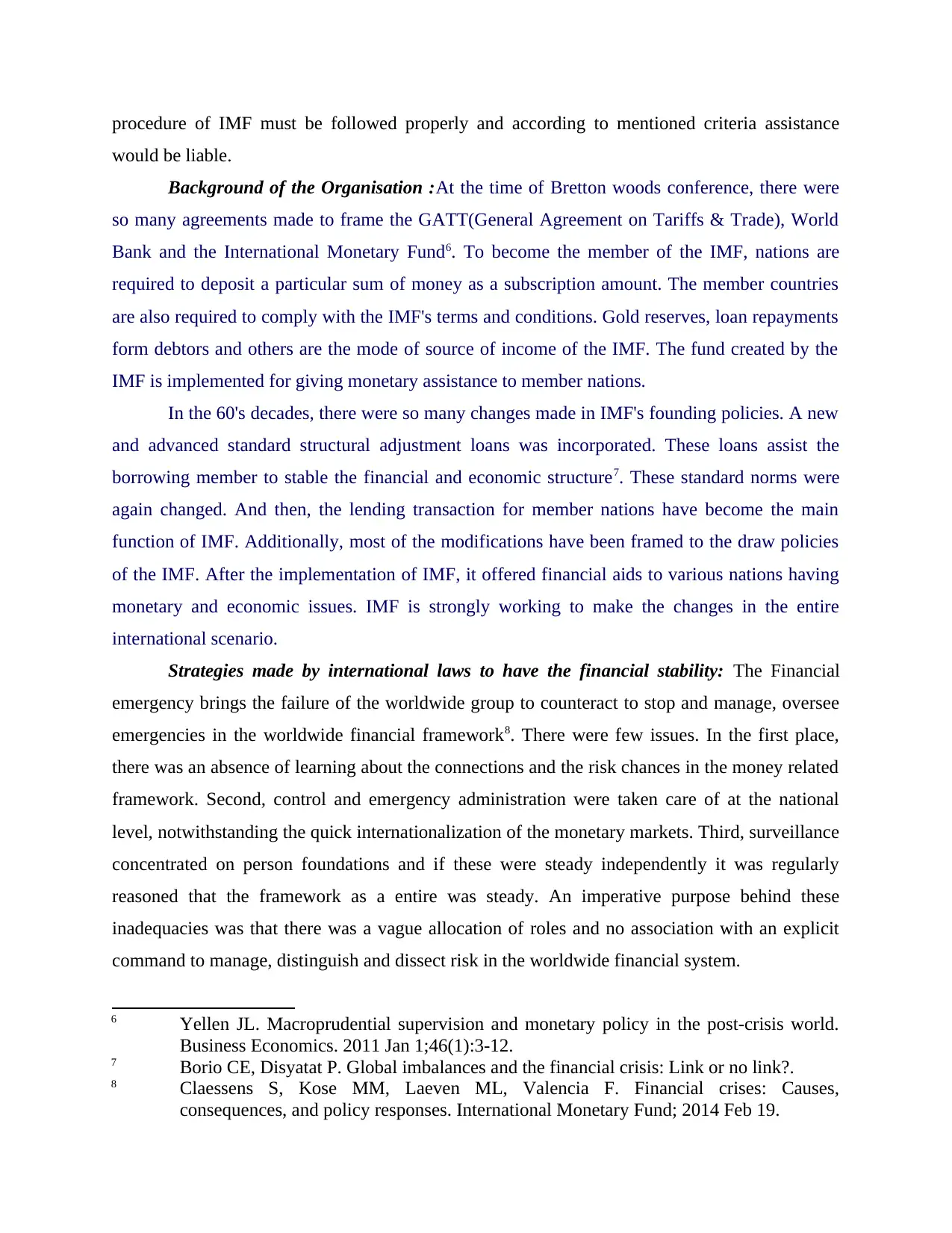
procedure of IMF must be followed properly and according to mentioned criteria assistance
would be liable.
Background of the Organisation :At the time of Bretton woods conference, there were
so many agreements made to frame the GATT(General Agreement on Tariffs & Trade), World
Bank and the International Monetary Fund6. To become the member of the IMF, nations are
required to deposit a particular sum of money as a subscription amount. The member countries
are also required to comply with the IMF's terms and conditions. Gold reserves, loan repayments
form debtors and others are the mode of source of income of the IMF. The fund created by the
IMF is implemented for giving monetary assistance to member nations.
In the 60's decades, there were so many changes made in IMF's founding policies. A new
and advanced standard structural adjustment loans was incorporated. These loans assist the
borrowing member to stable the financial and economic structure7. These standard norms were
again changed. And then, the lending transaction for member nations have become the main
function of IMF. Additionally, most of the modifications have been framed to the draw policies
of the IMF. After the implementation of IMF, it offered financial aids to various nations having
monetary and economic issues. IMF is strongly working to make the changes in the entire
international scenario.
Strategies made by international laws to have the financial stability: The Financial
emergency brings the failure of the worldwide group to counteract to stop and manage, oversee
emergencies in the worldwide financial framework8. There were few issues. In the first place,
there was an absence of learning about the connections and the risk chances in the money related
framework. Second, control and emergency administration were taken care of at the national
level, notwithstanding the quick internationalization of the monetary markets. Third, surveillance
concentrated on person foundations and if these were steady independently it was regularly
reasoned that the framework as a entire was steady. An imperative purpose behind these
inadequacies was that there was a vague allocation of roles and no association with an explicit
command to manage, distinguish and dissect risk in the worldwide financial system.
6 Yellen JL. Macroprudential supervision and monetary policy in the post-crisis world.
Business Economics. 2011 Jan 1;46(1):3-12.
7 Borio CE, Disyatat P. Global imbalances and the financial crisis: Link or no link?.
8 Claessens S, Kose MM, Laeven ML, Valencia F. Financial crises: Causes,
consequences, and policy responses. International Monetary Fund; 2014 Feb 19.
would be liable.
Background of the Organisation :At the time of Bretton woods conference, there were
so many agreements made to frame the GATT(General Agreement on Tariffs & Trade), World
Bank and the International Monetary Fund6. To become the member of the IMF, nations are
required to deposit a particular sum of money as a subscription amount. The member countries
are also required to comply with the IMF's terms and conditions. Gold reserves, loan repayments
form debtors and others are the mode of source of income of the IMF. The fund created by the
IMF is implemented for giving monetary assistance to member nations.
In the 60's decades, there were so many changes made in IMF's founding policies. A new
and advanced standard structural adjustment loans was incorporated. These loans assist the
borrowing member to stable the financial and economic structure7. These standard norms were
again changed. And then, the lending transaction for member nations have become the main
function of IMF. Additionally, most of the modifications have been framed to the draw policies
of the IMF. After the implementation of IMF, it offered financial aids to various nations having
monetary and economic issues. IMF is strongly working to make the changes in the entire
international scenario.
Strategies made by international laws to have the financial stability: The Financial
emergency brings the failure of the worldwide group to counteract to stop and manage, oversee
emergencies in the worldwide financial framework8. There were few issues. In the first place,
there was an absence of learning about the connections and the risk chances in the money related
framework. Second, control and emergency administration were taken care of at the national
level, notwithstanding the quick internationalization of the monetary markets. Third, surveillance
concentrated on person foundations and if these were steady independently it was regularly
reasoned that the framework as a entire was steady. An imperative purpose behind these
inadequacies was that there was a vague allocation of roles and no association with an explicit
command to manage, distinguish and dissect risk in the worldwide financial system.
6 Yellen JL. Macroprudential supervision and monetary policy in the post-crisis world.
Business Economics. 2011 Jan 1;46(1):3-12.
7 Borio CE, Disyatat P. Global imbalances and the financial crisis: Link or no link?.
8 Claessens S, Kose MM, Laeven ML, Valencia F. Financial crises: Causes,
consequences, and policy responses. International Monetary Fund; 2014 Feb 19.
⊘ This is a preview!⊘
Do you want full access?
Subscribe today to unlock all pages.

Trusted by 1+ million students worldwide
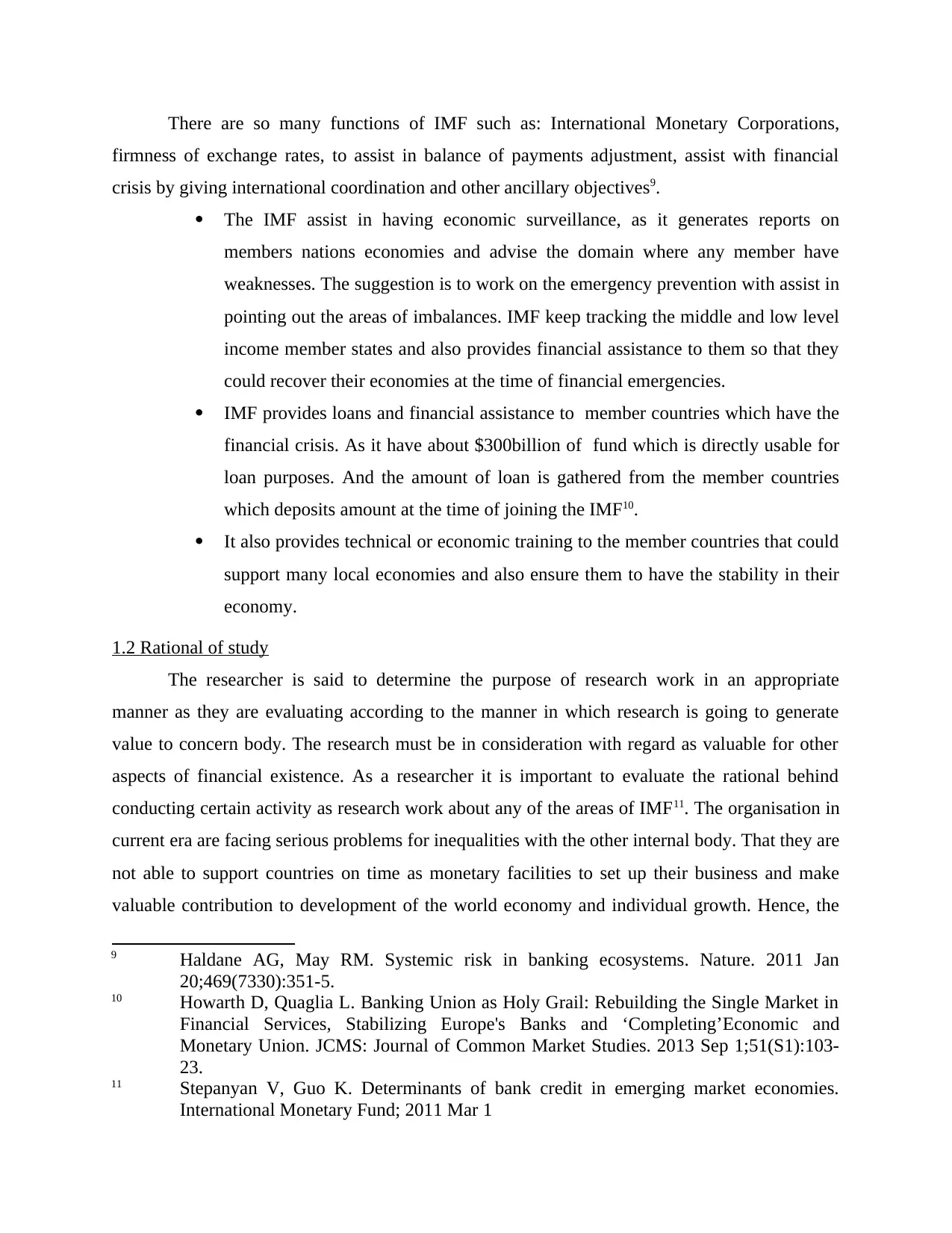
There are so many functions of IMF such as: International Monetary Corporations,
firmness of exchange rates, to assist in balance of payments adjustment, assist with financial
crisis by giving international coordination and other ancillary objectives9.
The IMF assist in having economic surveillance, as it generates reports on
members nations economies and advise the domain where any member have
weaknesses. The suggestion is to work on the emergency prevention with assist in
pointing out the areas of imbalances. IMF keep tracking the middle and low level
income member states and also provides financial assistance to them so that they
could recover their economies at the time of financial emergencies.
IMF provides loans and financial assistance to member countries which have the
financial crisis. As it have about $300billion of fund which is directly usable for
loan purposes. And the amount of loan is gathered from the member countries
which deposits amount at the time of joining the IMF10.
It also provides technical or economic training to the member countries that could
support many local economies and also ensure them to have the stability in their
economy.
1.2 Rational of study
The researcher is said to determine the purpose of research work in an appropriate
manner as they are evaluating according to the manner in which research is going to generate
value to concern body. The research must be in consideration with regard as valuable for other
aspects of financial existence. As a researcher it is important to evaluate the rational behind
conducting certain activity as research work about any of the areas of IMF11. The organisation in
current era are facing serious problems for inequalities with the other internal body. That they are
not able to support countries on time as monetary facilities to set up their business and make
valuable contribution to development of the world economy and individual growth. Hence, the
9 Haldane AG, May RM. Systemic risk in banking ecosystems. Nature. 2011 Jan
20;469(7330):351-5.
10 Howarth D, Quaglia L. Banking Union as Holy Grail: Rebuilding the Single Market in
Financial Services, Stabilizing Europe's Banks and ‘Completing’Economic and
Monetary Union. JCMS: Journal of Common Market Studies. 2013 Sep 1;51(S1):103-
23.
11 Stepanyan V, Guo K. Determinants of bank credit in emerging market economies.
International Monetary Fund; 2011 Mar 1
firmness of exchange rates, to assist in balance of payments adjustment, assist with financial
crisis by giving international coordination and other ancillary objectives9.
The IMF assist in having economic surveillance, as it generates reports on
members nations economies and advise the domain where any member have
weaknesses. The suggestion is to work on the emergency prevention with assist in
pointing out the areas of imbalances. IMF keep tracking the middle and low level
income member states and also provides financial assistance to them so that they
could recover their economies at the time of financial emergencies.
IMF provides loans and financial assistance to member countries which have the
financial crisis. As it have about $300billion of fund which is directly usable for
loan purposes. And the amount of loan is gathered from the member countries
which deposits amount at the time of joining the IMF10.
It also provides technical or economic training to the member countries that could
support many local economies and also ensure them to have the stability in their
economy.
1.2 Rational of study
The researcher is said to determine the purpose of research work in an appropriate
manner as they are evaluating according to the manner in which research is going to generate
value to concern body. The research must be in consideration with regard as valuable for other
aspects of financial existence. As a researcher it is important to evaluate the rational behind
conducting certain activity as research work about any of the areas of IMF11. The organisation in
current era are facing serious problems for inequalities with the other internal body. That they are
not able to support countries on time as monetary facilities to set up their business and make
valuable contribution to development of the world economy and individual growth. Hence, the
9 Haldane AG, May RM. Systemic risk in banking ecosystems. Nature. 2011 Jan
20;469(7330):351-5.
10 Howarth D, Quaglia L. Banking Union as Holy Grail: Rebuilding the Single Market in
Financial Services, Stabilizing Europe's Banks and ‘Completing’Economic and
Monetary Union. JCMS: Journal of Common Market Studies. 2013 Sep 1;51(S1):103-
23.
11 Stepanyan V, Guo K. Determinants of bank credit in emerging market economies.
International Monetary Fund; 2011 Mar 1
Paraphrase This Document
Need a fresh take? Get an instant paraphrase of this document with our AI Paraphraser
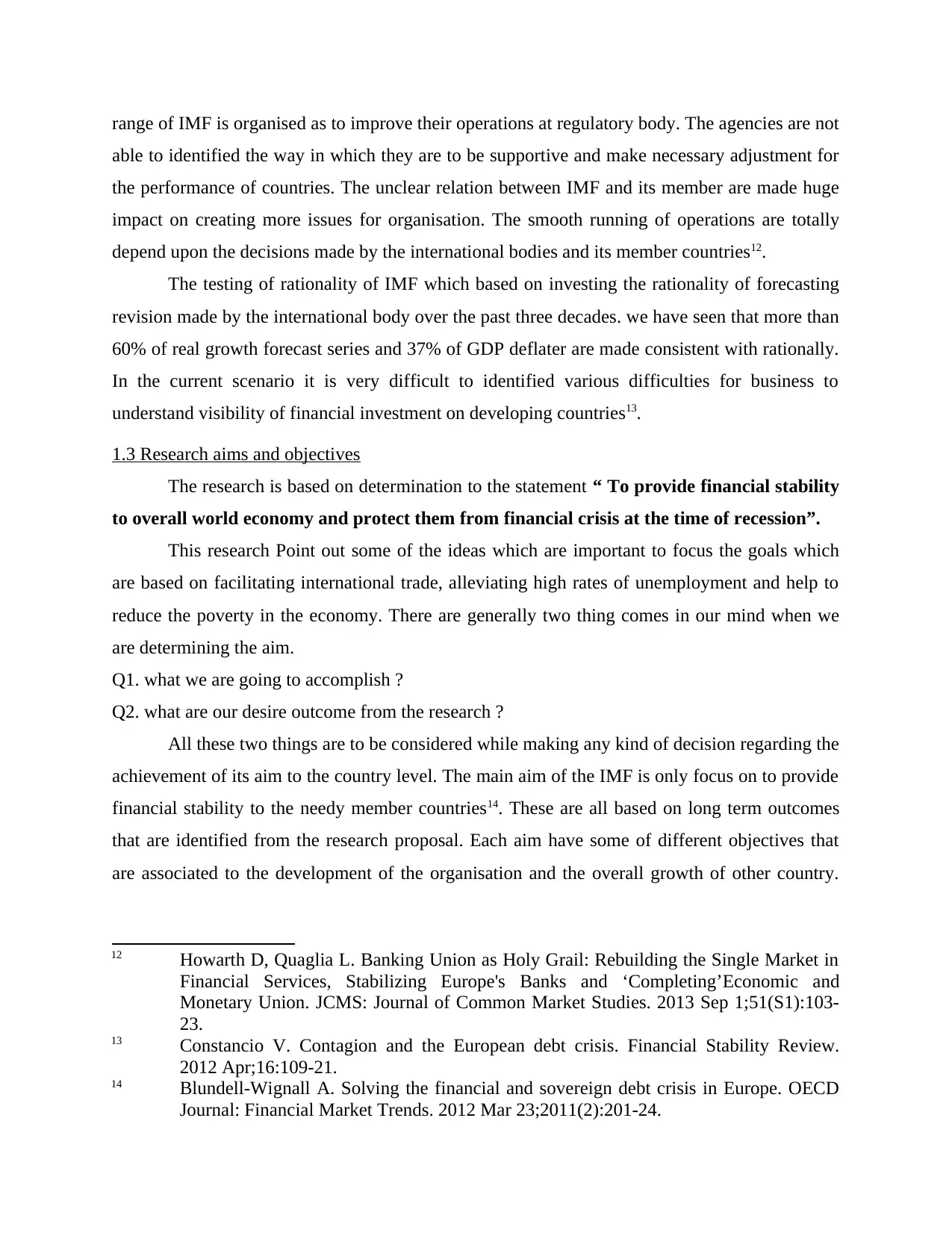
range of IMF is organised as to improve their operations at regulatory body. The agencies are not
able to identified the way in which they are to be supportive and make necessary adjustment for
the performance of countries. The unclear relation between IMF and its member are made huge
impact on creating more issues for organisation. The smooth running of operations are totally
depend upon the decisions made by the international bodies and its member countries12.
The testing of rationality of IMF which based on investing the rationality of forecasting
revision made by the international body over the past three decades. we have seen that more than
60% of real growth forecast series and 37% of GDP deflater are made consistent with rationally.
In the current scenario it is very difficult to identified various difficulties for business to
understand visibility of financial investment on developing countries13.
1.3 Research aims and objectives
The research is based on determination to the statement “ To provide financial stability
to overall world economy and protect them from financial crisis at the time of recession”.
This research Point out some of the ideas which are important to focus the goals which
are based on facilitating international trade, alleviating high rates of unemployment and help to
reduce the poverty in the economy. There are generally two thing comes in our mind when we
are determining the aim.
Q1. what we are going to accomplish ?
Q2. what are our desire outcome from the research ?
All these two things are to be considered while making any kind of decision regarding the
achievement of its aim to the country level. The main aim of the IMF is only focus on to provide
financial stability to the needy member countries14. These are all based on long term outcomes
that are identified from the research proposal. Each aim have some of different objectives that
are associated to the development of the organisation and the overall growth of other country.
12 Howarth D, Quaglia L. Banking Union as Holy Grail: Rebuilding the Single Market in
Financial Services, Stabilizing Europe's Banks and ‘Completing’Economic and
Monetary Union. JCMS: Journal of Common Market Studies. 2013 Sep 1;51(S1):103-
23.
13 Constancio V. Contagion and the European debt crisis. Financial Stability Review.
2012 Apr;16:109-21.
14 Blundell-Wignall A. Solving the financial and sovereign debt crisis in Europe. OECD
Journal: Financial Market Trends. 2012 Mar 23;2011(2):201-24.
able to identified the way in which they are to be supportive and make necessary adjustment for
the performance of countries. The unclear relation between IMF and its member are made huge
impact on creating more issues for organisation. The smooth running of operations are totally
depend upon the decisions made by the international bodies and its member countries12.
The testing of rationality of IMF which based on investing the rationality of forecasting
revision made by the international body over the past three decades. we have seen that more than
60% of real growth forecast series and 37% of GDP deflater are made consistent with rationally.
In the current scenario it is very difficult to identified various difficulties for business to
understand visibility of financial investment on developing countries13.
1.3 Research aims and objectives
The research is based on determination to the statement “ To provide financial stability
to overall world economy and protect them from financial crisis at the time of recession”.
This research Point out some of the ideas which are important to focus the goals which
are based on facilitating international trade, alleviating high rates of unemployment and help to
reduce the poverty in the economy. There are generally two thing comes in our mind when we
are determining the aim.
Q1. what we are going to accomplish ?
Q2. what are our desire outcome from the research ?
All these two things are to be considered while making any kind of decision regarding the
achievement of its aim to the country level. The main aim of the IMF is only focus on to provide
financial stability to the needy member countries14. These are all based on long term outcomes
that are identified from the research proposal. Each aim have some of different objectives that
are associated to the development of the organisation and the overall growth of other country.
12 Howarth D, Quaglia L. Banking Union as Holy Grail: Rebuilding the Single Market in
Financial Services, Stabilizing Europe's Banks and ‘Completing’Economic and
Monetary Union. JCMS: Journal of Common Market Studies. 2013 Sep 1;51(S1):103-
23.
13 Constancio V. Contagion and the European debt crisis. Financial Stability Review.
2012 Apr;16:109-21.
14 Blundell-Wignall A. Solving the financial and sovereign debt crisis in Europe. OECD
Journal: Financial Market Trends. 2012 Mar 23;2011(2):201-24.
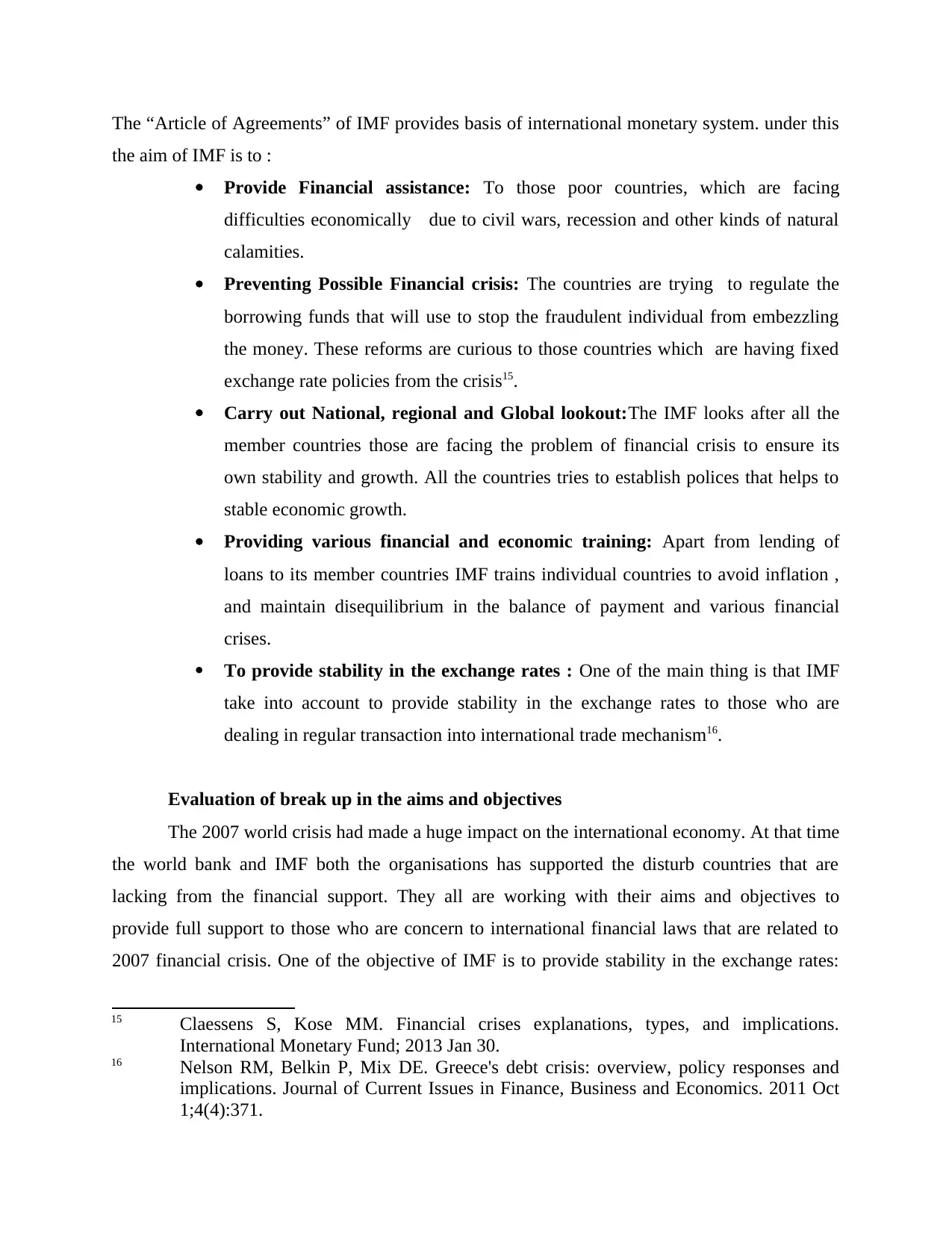
The “Article of Agreements” of IMF provides basis of international monetary system. under this
the aim of IMF is to :
Provide Financial assistance: To those poor countries, which are facing
difficulties economically due to civil wars, recession and other kinds of natural
calamities.
Preventing Possible Financial crisis: The countries are trying to regulate the
borrowing funds that will use to stop the fraudulent individual from embezzling
the money. These reforms are curious to those countries which are having fixed
exchange rate policies from the crisis15.
Carry out National, regional and Global lookout:The IMF looks after all the
member countries those are facing the problem of financial crisis to ensure its
own stability and growth. All the countries tries to establish polices that helps to
stable economic growth.
Providing various financial and economic training: Apart from lending of
loans to its member countries IMF trains individual countries to avoid inflation ,
and maintain disequilibrium in the balance of payment and various financial
crises.
To provide stability in the exchange rates : One of the main thing is that IMF
take into account to provide stability in the exchange rates to those who are
dealing in regular transaction into international trade mechanism16.
Evaluation of break up in the aims and objectives
The 2007 world crisis had made a huge impact on the international economy. At that time
the world bank and IMF both the organisations has supported the disturb countries that are
lacking from the financial support. They all are working with their aims and objectives to
provide full support to those who are concern to international financial laws that are related to
2007 financial crisis. One of the objective of IMF is to provide stability in the exchange rates:
15 Claessens S, Kose MM. Financial crises explanations, types, and implications.
International Monetary Fund; 2013 Jan 30.
16 Nelson RM, Belkin P, Mix DE. Greece's debt crisis: overview, policy responses and
implications. Journal of Current Issues in Finance, Business and Economics. 2011 Oct
1;4(4):371.
the aim of IMF is to :
Provide Financial assistance: To those poor countries, which are facing
difficulties economically due to civil wars, recession and other kinds of natural
calamities.
Preventing Possible Financial crisis: The countries are trying to regulate the
borrowing funds that will use to stop the fraudulent individual from embezzling
the money. These reforms are curious to those countries which are having fixed
exchange rate policies from the crisis15.
Carry out National, regional and Global lookout:The IMF looks after all the
member countries those are facing the problem of financial crisis to ensure its
own stability and growth. All the countries tries to establish polices that helps to
stable economic growth.
Providing various financial and economic training: Apart from lending of
loans to its member countries IMF trains individual countries to avoid inflation ,
and maintain disequilibrium in the balance of payment and various financial
crises.
To provide stability in the exchange rates : One of the main thing is that IMF
take into account to provide stability in the exchange rates to those who are
dealing in regular transaction into international trade mechanism16.
Evaluation of break up in the aims and objectives
The 2007 world crisis had made a huge impact on the international economy. At that time
the world bank and IMF both the organisations has supported the disturb countries that are
lacking from the financial support. They all are working with their aims and objectives to
provide full support to those who are concern to international financial laws that are related to
2007 financial crisis. One of the objective of IMF is to provide stability in the exchange rates:
15 Claessens S, Kose MM. Financial crises explanations, types, and implications.
International Monetary Fund; 2013 Jan 30.
16 Nelson RM, Belkin P, Mix DE. Greece's debt crisis: overview, policy responses and
implications. Journal of Current Issues in Finance, Business and Economics. 2011 Oct
1;4(4):371.
⊘ This is a preview!⊘
Do you want full access?
Subscribe today to unlock all pages.

Trusted by 1+ million students worldwide
1 out of 60
Related Documents
Your All-in-One AI-Powered Toolkit for Academic Success.
+13062052269
info@desklib.com
Available 24*7 on WhatsApp / Email
![[object Object]](/_next/static/media/star-bottom.7253800d.svg)
Unlock your academic potential
Copyright © 2020–2025 A2Z Services. All Rights Reserved. Developed and managed by ZUCOL.





